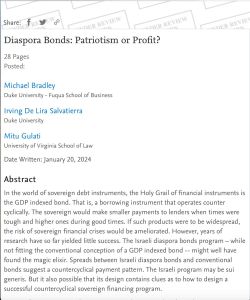
Recommendation
“Diaspora bonds” gain the attention of overseas nationals eager to support their homelands, even at returns lower than those of conventional bonds. Israel is probably the best-known issuer of diaspora bonds. The dynamics of Israel’s financing model suggest a way forward for GDP-indexed bonds – countercyclical debt instruments that would pay more to investors in good economic times and less during downturns. Finance experts Michael Bradley, Irving Arturo De Lira Salvatierra and Mitu Galati analyze the potential impacts of these bonds, particularly for developing economies, in this thorough, insightful report for investors and financial professionals.
Summary
About the Authors
Michael Bradley is a professor at the Fuqua Business School at Duke University. Irving Arturo De Lira Salvatierra is with IO Quantum. Mitu Gulati is a law professor at the University of Virginia’s Law School.







Comment on this summary